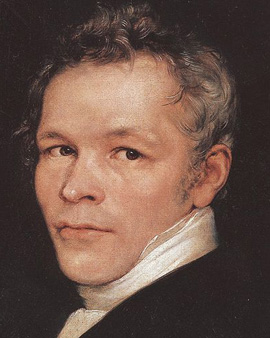n his paintings, the grace of architecture is shown in the context of the beauty of the landscape. Embedded in hills, mountains and plains created by nature, strong walls rise up to protect castles. The Prussian architect and painter Karl Friedrich Schinkel (1781-1841) understood European architecture as a continuation of ancient Greek architecture. The outstanding musical talent of the pastor's son, who came from Neuruppin, was already noticeable during his time at grammar school. After visiting an exhibition of architectural drawings, the young Schinkel decided to take up the profession of architect. He became a pupil at the private building school of Friedrich and David Gilly in Berlin. At the same time, he began to study architecture at the Berlin Bauakademie and attended lectures at the Akademie der Künste.
At the beginning of the new century, Schinkel was one of the first to take the professional examinations for civil service, which entitles him to work as a construction manager or building inspector. However, due to the financial misery of Prussia in connection with the war against Napoleon around 1800, only a few new building projects could be realized. So Friedrich Schinkel decided to go out and see the world after the implementation of the first construction and planning works. His way led him to Dresden, Prague, Vienna, Venice, Padua, Turin, Palermo, Naples, Lyon and Paris. Via Strasbourg and Weimar he returned to Berlin. There he exhibited panorama pictures inspired by the journey. Among the admirers of these works were King Frederick William III and Queen Luise of Prussia. Thus Schinkel was commissioned to redesign Queen Luise's bedchamber in the Kronprinzenpalais and to design the interior decoration of her rooms in the Berlin City Palace. With this commission, he became the interior designer and master builder of the Prussian royal house.
In his position as senior building officer, Schinkel was responsible for turning Berlin into the representative capital of Prussia. His responsibilities also extended to other construction projects from Cologne to Königsberg. Even today, the Königswache, the Schauspielhaus and the Altes Museum in Berlin bear witness to Karl Friedrich Schinkel's work. He became probably the most important architect of Classicism and was in friendly contact and lively intellectual exchange with contemporaries such as Wilhelm von Humboldt, Johann Wolfgang von Goethe, Count Hermann von Pückler-Muskau and Clemens von Brentano. Even when architecture became increasingly important to him, Karl Friedrich Schinkel continued to devote himself intensively to painting. For him, the two arts were inseparably linked.
×





 for a production in Berlin 1816 (wc) - (MeisterDrucke-58854).jpg)
 for a production in Berlin 1816 (wc) - (MeisterDrucke-58854).jpg)
.jpg)
.jpg)
.jpg)
.jpg)
.jpg)
.jpg)
 - (MeisterDrucke-81574).jpg)
 - (MeisterDrucke-81574).jpg)
.jpg)
.jpg)
.jpg)
.jpg)
.jpg)
.jpg)
.jpg)
.jpg)
 - (MeisterDrucke-50090).jpg)
 - (MeisterDrucke-50090).jpg)
.jpg)
.jpg)
 - (MeisterDrucke-172330).jpg)
 - (MeisterDrucke-172330).jpg)
 - (MeisterDrucke-70461).jpg)
 - (MeisterDrucke-70461).jpg)
.jpg)
.jpg)
_-_(MeisterDrucke-594132).jpg)
_-_(MeisterDrucke-594132).jpg)
.jpg)
.jpg)
.jpg)
.jpg)
.jpg)
.jpg)
.jpg)
.jpg)
_-_(MeisterDrucke-1123313).jpg)
_-_(MeisterDrucke-1123313).jpg)
.jpg)
.jpg)
.jpg)
.jpg)
.jpg)
.jpg)
.jpg)
.jpg)
.jpg)
.jpg)
.jpg)
.jpg)
.jpg)
.jpg)
.jpg)
.jpg)
.jpg)
.jpg)
 - (MeisterDrucke-123314).jpg)
 - (MeisterDrucke-123314).jpg)
_-_(MeisterDrucke-594128).jpg)
_-_(MeisterDrucke-594128).jpg)
.jpg)
.jpg)
.jpg)
.jpg)
.jpg)
.jpg)
.jpg)
.jpg)
.jpg)
.jpg)
.jpg)
.jpg)
.jpg)
.jpg)
.jpg)
.jpg)
.jpg)
.jpg)
.jpg)
.jpg)
.jpg)
.jpg)
_engraving_by_Karl_Fried_-_(MeisterDrucke-1110110).jpg)
_engraving_by_Karl_Fried_-_(MeisterDrucke-1110110).jpg)
_Oil_on_canvas_-_(MeisterDrucke-1011148).jpg)
_Oil_on_canvas_-_(MeisterDrucke-1011148).jpg)
_Oil_on_canvas_-_(MeisterDrucke-1028726).jpg)
_Oil_on_canvas_-_(MeisterDrucke-1028726).jpg)
_by_Wolfgan_-_(MeisterDrucke-970902).jpg)
_by_Wolfgan_-_(MeisterDrucke-970902).jpg)
.jpg)
.jpg)
.jpg)
.jpg)
.jpg)
.jpg)
_by_Wolfgan_-_(MeisterDrucke-982023).jpg)
_by_Wolfgan_-_(MeisterDrucke-982023).jpg)
.jpg)
.jpg)
.jpg)
.jpg)
.jpg)
.jpg)
.jpg)
.jpg)
.jpg)
.jpg)
_-_(MeisterDrucke-1315474).jpg)
_-_(MeisterDrucke-1315474).jpg)
.jpg)
.jpg)
.jpg)
.jpg)
.jpg)
.jpg)
.jpg)
.jpg)
.jpg)
.jpg)
.jpg)
.jpg)
.jpg)
.jpg)
.jpg)
.jpg)
.jpg)
.jpg)
.jpg)
.jpg)
.jpg)
.jpg)
.jpg)
.jpg)
.jpg)
.jpg)
.jpg)
.jpg)
.jpg)
.jpg)
.jpg)
.jpg)
.jpg)
.jpg)
.jpg)
.jpg)
.jpg)
.jpg)
.jpg)
.jpg)
.jpg)
.jpg)
.jpg)
.jpg)
.jpg)
.jpg)
.jpg)
.jpg)
.jpg)
.jpg)






